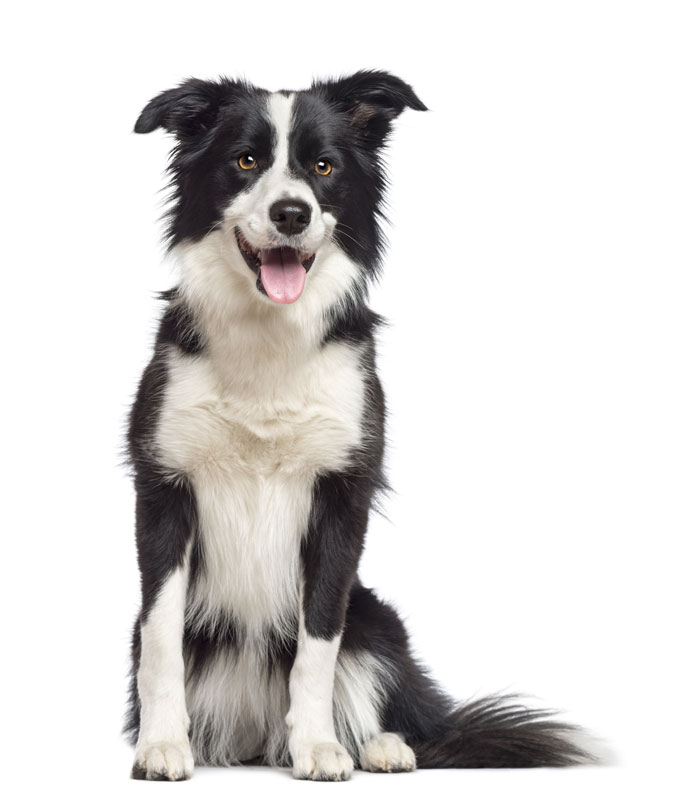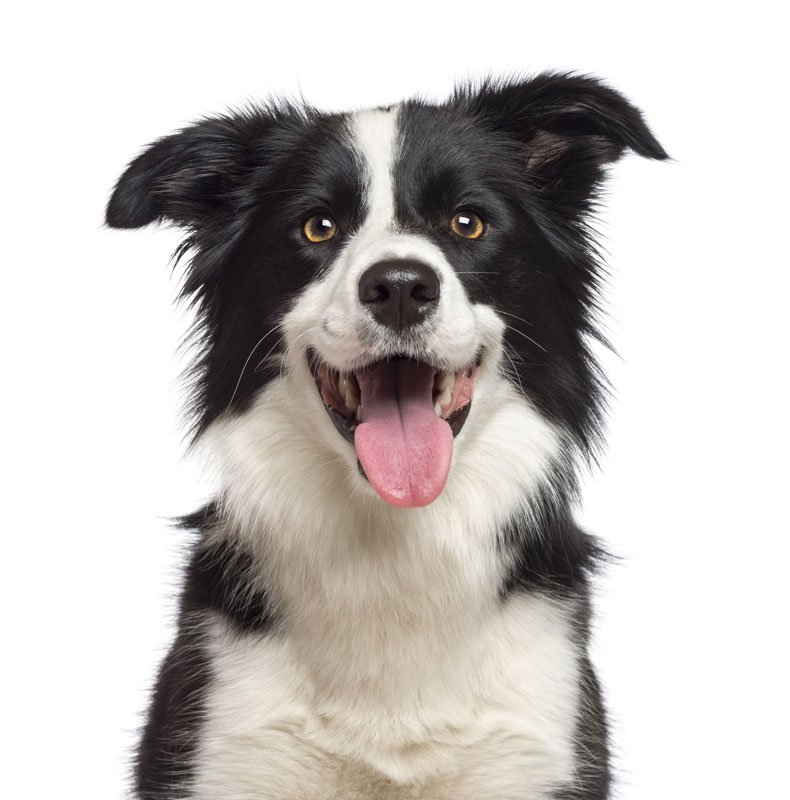The Border Collie is a working and Herding dog breed developed in the English-Scottish border region for herding livestock, especially sheep. It was specifically bred for intelligence and Obedience training. Ranked number one in Stanley Coren's The Intelligence of Dogs and typically extremely energetic, acrobatic, smart and athletic, they frequently compete with great success in dog sports, in addition to their success in sheepdog trials and are often cited as the most Animal cognition of all dogs. In January 2011, a Border Collie was reported to have learned 1,022 words and acts consequently to human citation of those words.
History
The Border Collie is descended from landrace collies, a type found widely in the British Isles. The name for the breed came from its probable place of origin along the Anglo-Scottish border. Mention of the "Collie" or "Colley" type first appeared toward the end of the 19th century, although the word "collie" is older than this and has its origin in the Scots language. It is also thought that the word 'collie' comes from the old Celtic word for useful. Many of the best Border Collies today can be traced back to a dog known as Old Hemp.In 1915, James Reid, Secretary of the International Sheep Dog Society (ISDS) in the United Kingdom first used the term "Border Collie" to distinguish those dogs registered by the ISDS from the Kennel Club's Collie (or Scotch Collie, including the Rough Collie and Smooth Collie) which originally came from the same working stock but had developed a different, standardised appearance following introduction to the show ring in 1860 and mixture with different types breeds.
Old Hemp
Old Hemp, a Tricolor_(dog)#Patterns dog, was born in September 1893 and died in May 1901. He was bred by Adam Telfer from Roy, a black and tan dog, and Meg, a black-coated, strong-eyed dog. Hemp was a quiet, powerful dog that sheep responded to easily. Many shepherds used him for stud and Hemp's working style became the Border Collie style. All pure Border Collies alive today can trace an ancestral line back to Old Hemp.
Wiston Cap
Wiston Cap (b. 28 Sep. 1963) is the dog that the International Sheep Dog Society (ISDS) badge portrays in the characteristic Border Collie herding pose. He was a popular stud dog in the history of the breed, and his bloodline can be seen in most bloodlines of the modern day Collie. In the late 1890s James Lilico (1861?–1945) of Christchurch, New Zealand, imported a number of working dogs from the United Kingdom. These included Hindhope Jed, a black, tan and white born in Hindhope, Scotland in 1895, as well as Maudie, Moss of Ancrum, Ness and Old Bob.It is unclear whether Hindhope Jed was a descendant of Old Hemp. Born two years after him, she is mentioned in a British Hunts and Huntsmen article concerning a Mr John Elliot of Jedburgh:
Mr Elliot himself is well known for his breed of Collies. His father supplied Noble to the late Queen Victoria and it was from our subject that the McLeod got Hindhope Jed, now the champion of New Zealand and Australia.
At the time of her departure to New Zealand, Hindhope Jed was already in pup to Captain, another of the then new "Border" strain. Hindhope Jed had won three trials in her native Scotland, and was considered to be the "best to cross the equator".In 1901 the King and Mcleod stud, created by Charles Beechworth King (b. 1855, Murrumbidgee, NSW), his brother and Alec McLeod at Canonbar, near Nyngan (north-west of Sydney), brought Hindhope Jed to Australia, where she enjoyed considerable success at sheep dog trials.
Health
Life span
The natural life span of the Border Collie is between 10 to 17 years, with an average lifespan of 12 years. The median longevities of breeds of similar size are usually 12 to 13 years.Leading causes of death are cancer (23.6%), old age (17.9%) and cerebral vascular afflictions (9.4%). CEA is a congenital, inherited eye disease involving the retina, choroid, and sclera that sometimes affects Border Collies. In Border Collies, it is generally a mild disease and rarely significantly impairs vision. There is now a DNA test available for CEA and, through its use, breeders can ensure that they will not produce affected pups. There are different types of hip testing available including OFA (Orthopedic Foundation for Animals) and PennHip. Radiographs are taken and sent to these organizations to determine a dog's hip and elbow quality.Two types of hearing loss occur in the breed. The first type is pigment associated and is found in Border Collie puppies. The second type is known as . These dogs have a normal auditory brainstem response test as pups but gradually lose their hearing some time between one and eight years of age. A study is currently underway at The Translational Genomics Research Institute to identify the genetic cause of adult onset hearing loss in the breed.Neuronal ceroid lipofuscinosis (NCL) is a rare but serious disease that is limited to show Border Collies. NCL results in severe neurological impairment and early death; afflicted dogs rarely survive beyond two years of age. The mutation causing the form of the disease found in Border Collies was identified by Scott Melville in the laboratory of Dr. Alan Wilton of the School of Biotechnology and Biomolecular Sciences, University of New South Wales. There is no treatment or cure, but a DNA test is now available to detect carriers as well as affected dogs.Trapped Neutrophil Syndrome (TNS) is a hereditary disease in which the bone marrow produces neutrophils (white cells) but is unable to effectively release them into the bloodstream. Affected puppies have an impaired immune system and will eventually die from infections they cannot fight. The mutation responsible for TNS has been found in Border Collies in English working dogs, in show dogs that had originated in Australia and New Zealand, and in unrelated Australian working dogs. This indicates that the gene is widespread and probably as old as the breed itself. TNS was identified by Jeremy Shearman in the laboratory of Dr. Alan Wilton of the School of Biotechnology and Biomolecular Sciences, University of New South Wales. There is no cure, but a DNA test is now available to detect carriers as well as affected dogs.Other diseases found less commonly include glaucoma, juvenile cataracts, osteochondritis, hypothyroidism and diabetes mellitus. A syndrome of exercise induced collapse similar to that seen in Labrador Retrievers (otherwise termed Border Collie Collapse)and triggered by episodes of collapse associated with periods of intense exercise has been described in Border Collies in North America, Europe and Australia; and is currently the subject of further investigation.Elbow dysplasia may also occur in the breed. Dogs homozygous for the Merle (coat colour in dogs) gene, sometimes referred to as "double merles", are likely to have ocular and/or auditory defects.
In popular culture
The primary character of the New Zealand comic strip Footrot Flats and the 1986 animated film adaptation Footrot Flats: The Dog's Tale is a working Border Collie named "Dog". Although the strip featured numerous human and farm animal characters it was told from the Dog's point of view.In the film, Babe (film), the piglet Babe is adopted by a working Border Collie named Fly and taught by her to herd sheep.











